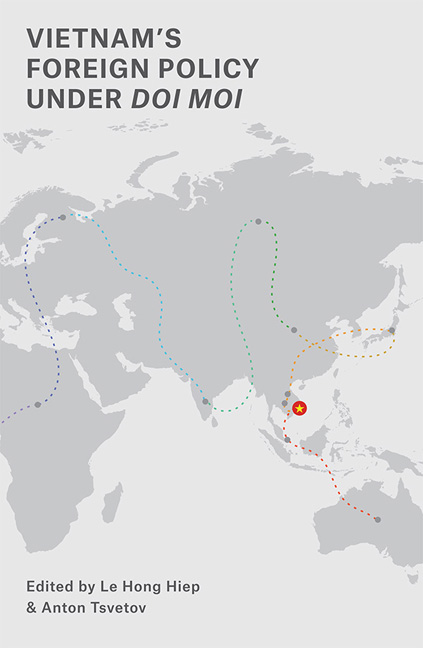Book contents
- Frontmatter
- Contents
- List of Tables
- List of Figures
- List of Abbreviations
- Acknowledgements
- About the Contributors
- PART I ANALYTICAL AND HISTORICAL FRAMEWORK
- 1 Introduction: The Making of Vietnam's Foreign Policy under Doi Moi
- 2 The Evolution of Vietnamese Diplomacy, 1986–2016
- PART II BILATERAL RELATIONSHIPS
- PART III MAJOR FOREIGN POLICY ISSUES
- Index
2 - The Evolution of Vietnamese Diplomacy, 1986–2016
from PART I - ANALYTICAL AND HISTORICAL FRAMEWORK
Published online by Cambridge University Press: 04 July 2018
- Frontmatter
- Contents
- List of Tables
- List of Figures
- List of Abbreviations
- Acknowledgements
- About the Contributors
- PART I ANALYTICAL AND HISTORICAL FRAMEWORK
- 1 Introduction: The Making of Vietnam's Foreign Policy under Doi Moi
- 2 The Evolution of Vietnamese Diplomacy, 1986–2016
- PART II BILATERAL RELATIONSHIPS
- PART III MAJOR FOREIGN POLICY ISSUES
- Index
Summary
This chapter presents a broad overview of the evolution of Vietnamese diplomacy from 1986 to the present. This thirty-year timeframe is divided into three parts. The first part highlights the seismic shifts in Vietnam's foreign policy after its adoption of Doi Moi in late 1986 until 1990. The second part assesses the implementation of Vietnam's foreign policy of “diversifying and multilateralizing” [đa dạng hóa, đa phương hóa] its external relations and becoming “a friend and reliable partner” [bạn bè và đối tác đáng tin cậy] to all countries during the period 1991–2005. The third part analyses Vietnam's proactive international integration, including the pursuit of strategic partnerships with the major powers and regional states, in the period 2006–16. This chapter concludes by noting that Vietnam has been able to make successful major strategic adjustments in its foreign policy to safeguard its sovereignty, national independence and territorial integrity over the past three decades.
Vietnam Joins the International Community, 1986–90
The year 1986 was a pivotal year in the evolution of Vietnam's domestic and foreign policy. Up until 1986, Vietnam had always regarded its relations with the Soviet Union and membership in the socialist camp as the cornerstone of its foreign policy.
Two major factors influenced Vietnam's decision to jettison outmoded Marxist–Leninist conceptions embodied in the “two world theory” that international relations were shaped and determined by the antagonistic contradictions between socialism and capitalism, or, more prosaically, as a struggle between friends and enemies and “who will triumph over whom” [ai thắng ai]. The first factor was Vietnam's mounting domestic socioeconomic crisis due to the breakdown of its Soviet-styled central planning system. The second factor was external and arose from the “new political thinking” emanating from the Soviet Union under the leadership of Mikhail Gorbachev (Palmujoki 1997; Thakur and Thayer 1987).
Due to the confluence of these domestic and external factors, Vietnam turned from a foreign policy structured by ideological considerations to a foreign policy framework that placed greater emphasis on national interest and pragmatic diplomacy. Vietnamese analysts now stressed global economic forces and the impact of the revolution in science and technology as key determinants of international relations (Cam 1995; Khoan 1995). Vietnam's changed worldview emerged gradually and nested with remnants of Leninist ideology.
- Type
- Chapter
- Information
- Vietnam's Foreign Policy under Doi Moi , pp. 23 - 44Publisher: ISEAS–Yusof Ishak InstitutePrint publication year: 2018

